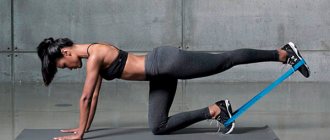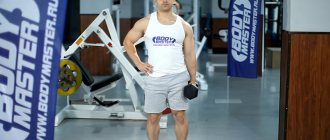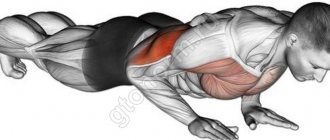Now cross-training has begun to gain popularity among many athletes and people who want to get their body in shape. You may notice that many fitness clubs now have their own cross-training area.
Cross-training is convenient because it can be done by almost anyone who wants to become fitter, stronger and healthier.
Cross-training workouts can most often be compared to interesting games for adults:
- Today you will be shown how to climb a rope correctly;
- And now you are doing an exercise with double jumping rope;
- Tomorrow you will have to do the entire training on special simulators, for example, row several kilometers on a rowing simulator!
Don't be alarmed if your cross-training session asks you to use a sledgehammer and huge truck tires. This is part of the workout that will help you become stronger and better!
What is cross training?
Cross training is a systematic set of high-intensity training consisting of a variety of exercises. This training system continues to gain increasing popularity among professional and amateur athletes. Cross-training has a beneficial effect on the cardiovascular and respiratory systems, helps you adapt to increased stress, and also develop skills such as strength, endurance, speed and agility.
Cross training combines elements of cardio and strength training, which allows you to use all the muscles of the body and effectively develop each of them. This is due to the involvement of exercises from different sports, which makes the final training option cross-training. A significant advantage of this complex is its accessibility, since classes require only basic equipment. Also, cross-training is a great way to stay fit for people who choose seasonal sports.
CrossFit contraindications
- Having problems with the respiratory or cardiovascular system;
- Pregnancy;
- Injuries of the musculoskeletal system;
- Recent surgeries;
- The presence of an acute illness;
- Acute infectious diseases;
- CNS lesions;
- Problems with the liver, kidneys, biliary or urinary tract;
- Mental problems;
- Gastrointestinal diseases.
If you decide to take up CrossFit, you must be prepared to carefully follow the training regimen, determine the work area, accurately perform each exercise, correctly combining it with rest and thereby giving the body time to recover.
How and to whom is cross-training useful?
One of the reasons why regular training is ineffective is monotony. Over time, the body gets used to a certain, constant load and stops developing at the right pace. This phenomenon is called the “plateau effect.” Cross training helps eliminate this effect due to the variety of techniques and practices used.
As mentioned earlier, cross-training is suitable not only for athletes, but also for amateurs. This type of training is suitable for anyone who wants to improve their health and physical performance. In addition, such a program allows you to try all the sports involved in it. If you have any difficulty deciding which sport to choose, this is a good opportunity to decide.
Benefits of Cross Training
Cross-training has a number of undeniable advantages:
- Variety . Complex functional training consists of various exercises, both similar to the main sport and completely opposite. This allows you to develop muscles that are not used during normal training.
- Training schedule . Long workouts of such intensity can negatively affect your health, so this program is suitable for people who have little free time. The recommended training schedule is 2-3 times a week for 30 minutes.
- Availability. To complete the complex you only need basic equipment. For some exercises, especially in the initial stages, it is not needed at all.
- Low chance of injury. The load is evenly distributed to each muscle group, which will eliminate possible weakened, untrained areas prone to injury.
- Improved reflexes. The development of such a physical indicator as speed leads to improved coordination and a sense of balance.
- Development of various physical qualities. This kind of training is aimed, first of all, at improving the entire range of physical indicators. A properly designed program, in addition to all of the above, will help keep muscles toned and give them relief.
There are also potential downsides to cross-training, such as exhaustion from too intense, unbalanced workouts, or ineffectiveness due to the wrong exercises. But if the complex is compiled correctly, the likelihood of problems occurring is minimized.
Pros and cons of CrossFit
Pros:
- The cardiovascular system is well pumped;
- Increases endurance;
- All muscle groups are comprehensively pumped during training;
- Metabolic processes improve;
- Sleep improves, you feel fresh and full of energy;
- Increases body flexibility and reduces the risk of injury;
- Combined with proper nutrition and a healthy lifestyle, CrossFit can be a quick option for losing weight;
- Many sports and strength qualities develop. After doing CrossFit regularly, you will be ready to run, jump, lift weights, etc.
Minuses:
- Since CrossFit is a universal thing, by doing it exclusively, you are unlikely to be the best in a certain discipline: run the fastest, jump higher than others, or lift the heaviest weights;
- CrossFit is quite dangerous because the level of intensity of training is often higher than in alternative sports. Follow the exercise technique to avoid injuries;
- The cardiovascular system is subjected to high load during CrossFit training, it is important not to overdo it;
What equipment do you need for cross training?
The list of items needed to perform the exercises is quite small:
- Horizontal bar.
- Jump rope.
- Rotary or regular push-up supports.
- Dumbbells, weights or a special vest, if available.
- Fitness bands, expander.
This is only a small part of the equipment of a regular gym. If you plan to exercise at home, then almost all of the equipment listed can be purchased at any sporting goods store. Depending on the exercises chosen, some items may be replaced with analogues or may not be needed at all.
What do you need for CrossFit?
Boxes (gyms) usually have almost all the necessary equipment for training, including rowing machines, plyo boxes, kettlebells, barbells and sledgehammers for CrossFit. Experts recommend investing in one key element: a quality jump rope.
Although gyms usually have their own jump ropes, they are short-lived and not designed to be shared by many people. So, some people shorten long jump ropes by tying them, which can interfere with the integrity of the equipment.
Don't waste your money and buy one that suits your length. A good bonus will be the electronic jump counter built into the model.
It's also worth investing in crossfit-specific flat shoes that are suitable for the different movements you'll encounter. Running shoes are not recommended because their soft design is not compatible with explosive exercises such as burpees.
How are cross-training sessions conducted?
Tuning training can be done in several ways:
- Diverse practices within one workout.
- Choosing a regular set of exercises with the addition of one day of another type of exercise.
- Daily alternation of different types of training throughout the week.
The training is divided into several stages and lasts from 30 to 60 minutes. You should start with a 30-minute workout, especially if you have not exercised for a long time. You should monitor your condition before, during and after training. You need to increase the time of exercise gradually, when you feel that the body is ready.
The first step is to do a 15-minute warm-up. This stage should not be neglected, as it will prepare the muscles for the main workout. The better the muscles are prepared, the easier it will be later. A cross-training warm-up includes running, squats, jumping and pull-ups, and other basic exercises.
This is followed by the main workout. It lasts about 15-20 minutes. The main task of this stage is to perform two to four special strength or cardio exercises. Exercises should be performed at high intensity, and breaks between them should be kept to a minimum.
The final stage (cool down and stretching) is designed to return the body to a state of rest. All exercises are performed slowly, breathing, pulse and blood pressure return to normal over time. In addition to exercises, you can use self-massage and light breathing exercises.
Types of training adjustments
Cross-training discipline is a modern name for a training adjustment method in which classes from different sports areas alternate. Lessons can be planned as follows:
- Combining a variety of exercises during one workout. In this case, you can add strength training to the end of the training or complete the training with flexibility exercises.
- Adding one day to the main training program with another type of activity. In this case, the athlete spends most of his time engaged in the selected type of load.
- Alternating combinations of several types of training throughout the week. Combining exercises comprehensively develops physical skills. The exact combination of indicators depends on the main type of training around which the rest of the regime is built.
This type is an effective method of training when playing any kind of sport. It is suitable for increasing flexibility during basic power loads and maintaining strength during basic plastic and flexibility exercises. Cross-training will help you feel truly complete physical development.
This is interesting
[uaf_vkcount url='https:///trenirovki-po-triatlonu-kak-podgotovitsya/'] Triathlon training, how to prepare?
What is cross-functional collaboration?
Cross-functional, or cross-functional, collaboration involves bringing together people with different functional knowledge to achieve better results in a common cause. An example of this collaboration would be a research group consisting of specialists from related fields of science. The strategy of creating diverse teams can help unite the team, as well as find innovative ways to solve problems. Returning to our topic, a combination of cross-training and cross-functional collaboration will be an effective mechanism for the continuous development of each of the participants.
At the initial stage, the logical solution would be to attract both athletes, preferably from different sports, and amateurs. Having people who understand the topic ensures that a balanced training program is created for the entire group. Also, if necessary, athletes will be able to help beginners and create additional motivation. Different physical fitness levels among group members will reduce the likelihood of overtraining problems. If some people need to increase or decrease the load, they can form a new group or move to another.
How to create a cross-functional team?
There are several ways to organize this type of association. Some of them are more effective, and some are less. However, according to statistics, the most productive activities are achieved by following the following recommendations:
- Emphasis on the versatility of each member. Sampling can be carried out on only one aspect - type of activity, but this is not enough to obtain the best results. You need to pay attention to such parameters as gender, experience, skill, individual abilities, worldview and others.
- Choosing the right leader. A team with a good leader is most often doomed to success, so the involvement of an influential person is important in such cooperation. People with natural leadership qualities will easily earn the respect and recognition of group members. As a result, due to the growth of the leader’s authority, the interest of the participants will also increase.
- Adding an expert to the team. Experts in the field related to the group's activities will be able to provide the most complete information to each participant, and will also become good teachers for beginners.
- Support for non-standard solutions. A cross-functional group includes specialists from different fields of activity, but this does not mean that each of them should always offer solutions only in their field. Abstract example: a runner learned from a martial arts master about the correct weight distribution in his sport. In turn, he can combine existing knowledge and acquired knowledge, creating a fundamentally new concept. The main task when putting forward such initiatives is to properly encourage them, drawing on the merits of each member of the group.
- Discipline. Each participant in joint activities must be interested in creating and maintaining discipline within the group. You need to try to reschedule training sessions as little as possible, set a clear schedule and distribute responsibilities. Sharing responsibilities will give people responsibility, but it will also help them feel important.
This is a list of only the most basic and general recommendations. Following these five tips will already bear fruit. Depending on the specific purpose, they can be supplemented and changed.
What challenges might you face in cross-functional collaboration?
Like many other strategies that rely on people to communicate, cross-functional collaboration is only ideal in theory. Even a careful sample of people cannot guarantee that there will be no problems. It often happens that people are selected based on their work in a certain environment, and when that environment changes, behavior, performance, initiative, and so on change.
In other words, the outcome of cross-functional collaboration in practice may be different from what was intended. There are several reasons for this:
- Isolation and abstraction. Almost any team tends over time to split into groups that rarely interact with each other. This ruins the whole idea of this type of cooperation. It is also not uncommon for some to stop trying, hoping that someone else will ensure the success of the group. The solution to both problems will be to create an atmosphere of trust and value for each participant in the activity. This difficult task falls on the shoulders of the leader. If he copes with this, the results will not take long to arrive.
- Mismatched goals. Inconsistent goals will directly affect performance, as the actions and decisions of one group member may conflict with the actions of another. Discrepancies in goals most often occur either from an initially incorrect sample or from a misunderstood task. The solution is to communicate the task clearly and clearly and encourage collaboration.
- Conflicts. Ideological and other interpersonal conflicts will interfere with people's communication. This problem is directly related to sampling. If it arose, it means that people were selected according to a small number of parameters, or even by chance. If the situation cannot be resolved, and this is already affecting productivity, the best solution would be to reform the group.
“Cross” is a prefix that speaks of the intersection, interweaving of something. The effectiveness of both cross-training and cross-functional collaboration lies in the use of multitudes to create something single, more complex and of higher quality. With proper analysis of the information received and compliance with all the above recommendations, these types of activities will inevitably become assistants on the path of development and self-improvement.










